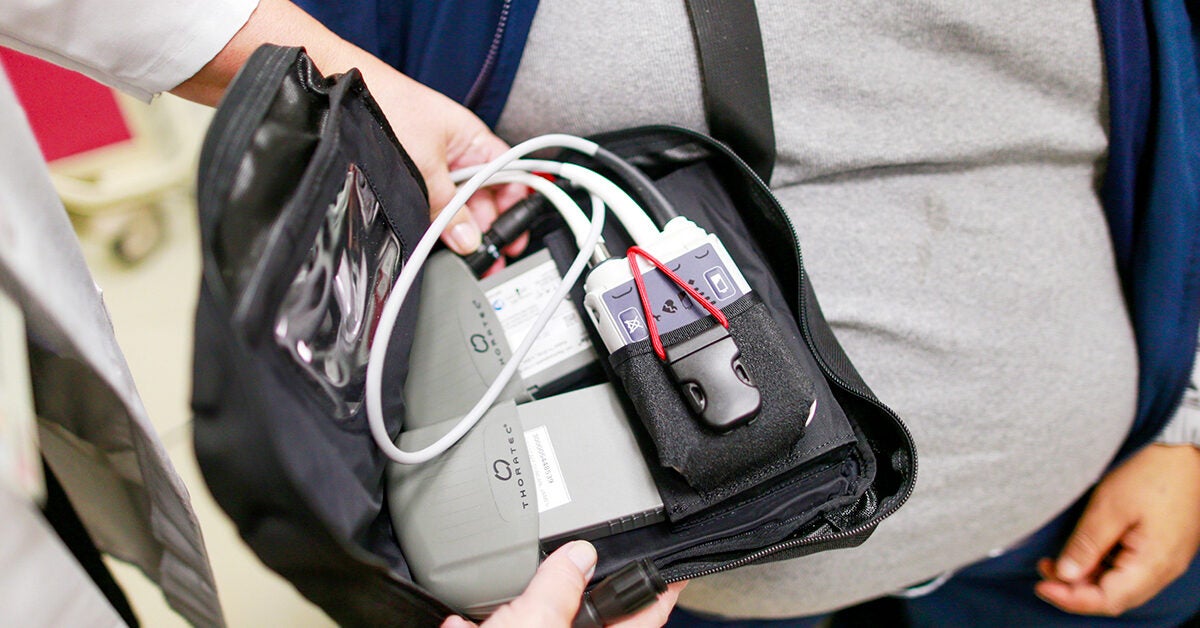Left Ventricular Assist Devices (LVAD) for Heart Conditions - Healthline

Left ventricular assistance devices (LVADs) are small, battery-operated pumps implanted into the chest to help the heart circulate blood. They're used to help people with end-stage heart failure, either to improve survival while waiting for a heart transplant or as the primary treatment.
The LVAD pump is attached to a controller with a cable that runs through a small port in your skin. LVADs have traditionally been implemented with open-heart surgery, but minimally invasive procedures are becoming more common.
The first LVAD was implemented in
Read on to learn how LVADs work, who they can help, and potential complications.
Your heart has four chambers. The top two chambers are called atriums and the bottom two are called ventricles.
Your left ventricle is responsible for pumping oxygenated blood from your heart to the major blood vessel that carries blood away from your heart called your aorta.
LVADs act as a partial artificial heart in people whose hearts are too weak to pump blood efficiently by themselves. They help pump oxygenated blood from your left ventricle into your aorta.
The basic design of LVADs has remained the same since they were FDA-approved in
- Pump. A tube is placed inside your left ventricle. Blood travels through this tube, into a pump just below your heart, and into your aorta through another tube.
- Driveline. The driveline is a cable that connects the pump to the controller. It travels through a hole in your abdomen.
- Controller. The controller powers the pump and gives you updates about whether the system is working properly.
- Batteries. Two batteries power the controller when it's not plugged in. The batteries can be carried on a belt, harness, or backpack.
LVADs are used to help manage end-stage heart failure.
Heart disease is the
When your coronary arteries become clogged, your heart is unable to pump blood adequately, which is known as heart failure.
The American Heart Association (AHA) has estimated that
Heart failure tends to gradually get worse over time. It's known as end-stage heart failure if it progresses to the point where your heart can't pump enough blood to meet your body's needs.
At this point, it causes symptoms such as:
Heart transplantation is still considered the
Bridge to transplantation
LVADs can provide support for people waiting for a heart to become available for transplantation.
Destination therapy
Destination therapy is when an LVAD is used as the primary treatment. It's used in people who
Bridge to the decision
People with end-stage organ failure due to heart failure are
Bridge to recovery
LVADs can provide temporary heart support for some people with heart failure and help promote recovery of heart function.
People with late-stage heart failure often experience less fatigue, more strength, and better breathing after receiving an LVAD.
In a
A
According to the AHA, about
Outcomes are currently more favorable for people who receive them as bridge-to-transplant. About
People receiving an LVAD as a destination therapy tend to have more health complications but 68 percent of people live at least
Survival rates have increased as technology improves, and likely will continue to do so in the future.
LVADs have traditionally been implanted with open-heart surgery, but minimally invasive surgical techniques are becoming more common. LVADs continue to get smaller, making minimally invasive surgery a more practical option.
Conventional open-heart surgery
During open-heart surgery, you'll likely experience something like this:
- You'll be put asleep with anesthesia administered through an IV.
- Your surgeon will make a large incision on your breastbone to access your heart by spreading your rib cage.
- A cardiopulmonary bypass machine will take over the work of your lung and heart.
- The surgeon will connect one end of the LVAD tube to your heart's left ventricle and the other end to your aorta. The driveline is connected to the pump and to batteries or a plug.
- Once your device is working correctly, you'll be taken off the cardiopulmonary bypass machine and your chest is closed with stitches.
Open-heart surgery usually takes 4 to 6 hours.
Minimally invasive alternatives
There are also various minimally invasive surgical techniques that are currently used or are under investigation. During a minimally invasive procedure, your doctor will make one or more smaller incisions to access your heart.
For example, during a thoracotomy procedure, the procedure is performed through the ribs instead of through the breastbone.
Despite the potential benefits of LVADs, every surgery comes with risk.
Here's a look at some of the complications of LVADs along with their reported rates, according to a
LVADs are expected to continue to get smaller over time and minimally invasive surgery is becoming more common. Minimally invasive LVAD surgery is expected to become the standard of care, making LVADs more widely available at
LVADs are mechanical pumps implanted below the heart to treat late-stage heart failure. They're used to treat people waiting for heart transplants or people ineligible for transplants. Many people experience an improvement in quality of life after receiving an LVAD.
The LVAD procedure comes with potential complications such as heavy bleeding or infection. Minimally invasive surgical techniques are becoming more popular and tend to cause fewer complications than traditional open-heart surgery.
The best way to know if you might benefit from an LVAD is by discussing it with your doctor. Your doctor can help you understand if you're eligible and help you weigh pros and cons.
Comments
Post a Comment